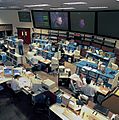Deep Space Network facts for kids
The Deep Space Network (DSN) is a special group of giant antennas that belong to NASA. Think of them as NASA's ears and mouths for talking to spacecraft far away in space. These antennas are located in three different places around the world.
Their main job is to communicate with satellites and probes that are exploring our solar system and beyond. They also listen for signals from stars and other interesting events happening in space.
Contents
What is the Deep Space Network?
The Deep Space Network is like a global communication system for space missions. It's made up of very large antennas that can send and receive radio signals over incredible distances. These signals travel millions, or even billions, of miles. The DSN is crucial for missions like those exploring Mars, Jupiter, or even the edge of our solar system.
How Does the DSN Work?
The DSN uses radio waves to talk to spacecraft. Imagine you're trying to talk to someone very, very far away. You'd need a powerful speaker and a sensitive microphone. The DSN antennas are exactly that!
- Sending Commands: When NASA wants a spacecraft to do something, like take a picture or change its direction, the DSN sends radio commands.
- Receiving Data: The spacecraft then sends back information, like amazing photos, scientific measurements, or updates on its health. The DSN antennas are designed to pick up these very faint signals.
- Listening to Space: Besides talking to spacecraft, the DSN also listens to natural radio waves coming from space. This helps scientists learn more about stars, galaxies, and other cosmic objects.
Where are the DSN Stations?
To make sure NASA can always talk to its spacecraft, the Deep Space Network has three main sites. These sites are spread out roughly one-third of the way around the Earth. This setup means that as our planet spins, at least one DSN station can always "see" and communicate with a spacecraft.
- Goldstone, California, USA: This complex is located in the Mojave Desert. It has several large antennas, including a massive 70-meter (230-foot) dish.
- Madrid, Spain: The Madrid Deep Space Communications Complex is near Robledo de Chavela. It also has a 70-meter antenna and other dishes.
- Canberra, Australia: The Canberra Deep Space Communication Complex is located near Tidbinbilla. Like the other two, it has a 70-meter antenna and plays a vital role in tracking missions.
These three stations work together 24 hours a day, 7 days a week, to keep NASA connected to its fleet of robotic explorers across the solar system.
Images for kids
-
70 m antenna at Goldstone, California.
-
70m antenna in Robledo de Chavela, Community of Madrid, Spain
See also
 In Spanish: Red del Espacio Profundo para niños
In Spanish: Red del Espacio Profundo para niños






